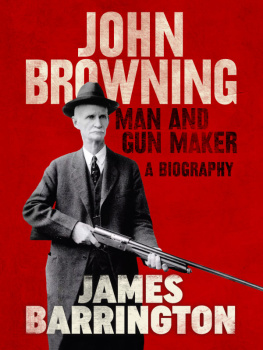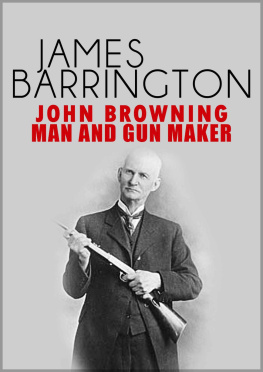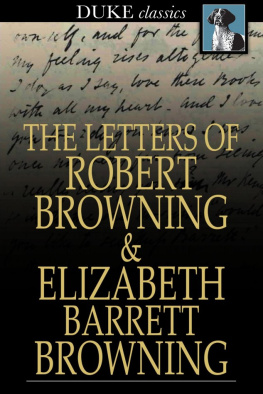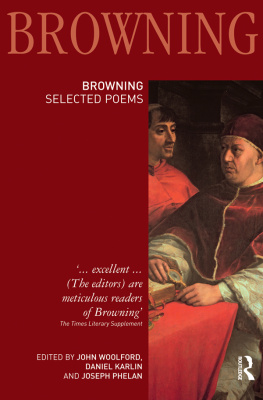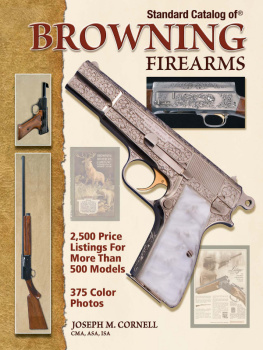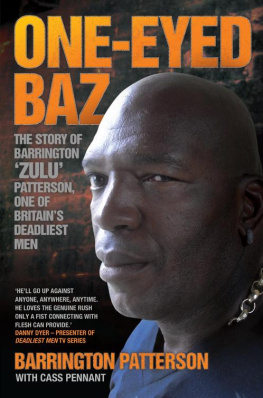James Barrington - John Browning: Man and Gun Maker
Here you can read online James Barrington - John Browning: Man and Gun Maker full text of the book (entire story) in english for free. Download pdf and epub, get meaning, cover and reviews about this ebook. year: 2018, genre: Non-fiction / History. Description of the work, (preface) as well as reviews are available. Best literature library LitArk.com created for fans of good reading and offers a wide selection of genres:
Romance novel
Science fiction
Adventure
Detective
Science
History
Home and family
Prose
Art
Politics
Computer
Non-fiction
Religion
Business
Children
Humor
Choose a favorite category and find really read worthwhile books. Enjoy immersion in the world of imagination, feel the emotions of the characters or learn something new for yourself, make an fascinating discovery.
- Book:John Browning: Man and Gun Maker
- Author:
- Genre:
- Year:2018
- Rating:3 / 5
- Favourites:Add to favourites
- Your mark:
- 60
- 1
- 2
- 3
- 4
- 5
John Browning: Man and Gun Maker: summary, description and annotation
We offer to read an annotation, description, summary or preface (depends on what the author of the book "John Browning: Man and Gun Maker" wrote himself). If you haven't found the necessary information about the book — write in the comments, we will try to find it.
James Barrington: author's other books
Who wrote John Browning: Man and Gun Maker? Find out the surname, the name of the author of the book and a list of all author's works by series.
John Browning: Man and Gun Maker — read online for free the complete book (whole text) full work
Below is the text of the book, divided by pages. System saving the place of the last page read, allows you to conveniently read the book "John Browning: Man and Gun Maker" online for free, without having to search again every time where you left off. Put a bookmark, and you can go to the page where you finished reading at any time.
Font size:
Interval:
Bookmark:


In any survey of the history of firearms development, it will quickly become apparent that the inventive genius of one man advanced the state of the art at a totally unprecedented and unsurpassed rate. He was the author of over one hundred separate patents covering virtually all types of weapon from pistols upwards, and was unique in that his designs constituted virtually the entire output of three major arms manufacturers in the first half of the last century, and have spawned countless imitations all over the world.
His name was John Moses Browning, whose name is probably most closely linked with the automatic pistols still produced by Fabrique Nationale in Belgium. But Browning was not just a designer of handguns; he also profoundly influenced the development of machine-guns, rifles and shotguns, and it is a measure of the enduring popularity of his designs that so many weapons covered by Browning patents are still manufactured today.
John Browning was the son of Jonathan Browning, a Mormon who had been part of the great Mormon Exodus from Nauvoo, Illinois, to Utah in 1852. Jonathan had been born in 1805, and had trained at an early age as an apprentice gunsmith by the unusual device of simply arriving on the doorstep of a Nashville gunmaker named Samuel Porter and offering to work for him for nothing in exchange for lessons in gun barrel-making. Porter was so impressed with Jonathans work that he soon started paying him a wage of two dollars a week, in addition to providing bed and board, and when, after three months, Jonathan announced that he was returning to the Browning home at Brushy Fork, Tennessee, offered him a share of the business if he would stay.
No doubt Jonathan was tempted, but remained adamant. The two men parted as firm friends, Porter supplying Jonathan with rifling and boring tools as well as a selection of mandrels used for hand-forging gun barrels of different sizes. Also included in his pack was a rifle made by Porter but carrying a barrel made entirely by Jonathan, and on which the older man had stamped JONATHAN BROWNING 1824.
From this small and inauspicious beginning, Jonathan Browning established himself as a competent rural gunmaker, repairing damaged weapons and producing rifles to order, but his aspirations were higher. Following marriage and a family move from Brushy Fork to Quincy, Illinois, in 1834, he concentrated his considerable abilities on the problem of designing a simple but efficient repeating rifle using the percussion system.
His endeavour succeeded, and the result was one of the simplest practical repeating weapons ever produced. Known as a slide gun, its five-shot magazine was fabricated from a solid rectangular bar, each chamber having an integral nipple, and was passed through the breech from side to side. The magazine was moved on after each shot by a thumb-operated lever, which also forced the chamber forward into a gas-tight alignment with the barrel, while the hammer was positioned below the breech in front of the trigger guard. Larger capacity magazines were available to special order, and each rifle was supplied with at least one spare magazine, thus giving the owner a minimum of ten rapid shots if required.
Crude though this may sound, the weapon was capable of sustained fire at a rate unequalled by any other weapon of the time, and as recently as 1952 an example of the weapon from the Browning Family Collection fired fifteen rounds without malfunction.
The rifle, which was not patented, was an immediate success in the area, producing far more orders than Jonathan could possibly fill, and would no doubt have become a generally popular weapon had Brownings manufacturing capacity been equal to his design ability.
In 1840 Jonathan Browning, by then an established member of the community and a good friend of the young Abraham Lincoln, became deeply interested in religion and, in particular, the teachings of the Mormon church. The direct result of this interest was the Browning familys move, in 1842, to the city of Nauvoo, Illinois, which was being constructed on the instructions of Joseph Smith, the founder and Prophet of the Church of Jesus Christ of Latter-Day Saints.
The Mormons were not popular, being subjected to frequent attack by armed Illinois and Missouri gangs, and the violence reached a peak in June 1844 when Joseph Smith and his brother, Hyrum, were assassinated at Carthage, Illinois. This action was the spur that led to the great Mormon Exodus under Brigham Young, which started in 1846 and continued for some years. Though Jonathan Browning was eager to head west with the pioneers, Young recognised his worth and insisted that he stay to provide the weapons so desperately needed by the Saints, and it wasnt until 1852 that Jonathan was permitted to follow the trail from Nauvoo that led eventually through the Rocky Mountains to Utah and Ogden in the valley of the Great Salt Lake.
The violence at Nauvoo and the long trek west had left their mark on Jonathan Browning, and he never again applied himself to the development of new weapons, contenting himself with repairing and refurbishing not only guns but any mechanical contraptions which required attention.
John Moses Browning was born in Ogden, Utah, on January 23 1855, and his brother Matthew Sandifer Browning, Johns life-long friend, confidant and business partner, on October 27 1859. From the first, the workshop where his father spent his days fascinated John Browning. By the time he was eight or nine he was often to be found there alone by customers requiring work on guns, and even at that age he was frequently able not only to diagnose the problem, but also to estimate the length of time it would take his father Jonathan to fix it.
He made his first gun at the age of ten; it was crude in the extreme, consisting of a sawn-off flintlock barrel attached to a roughly-shaped stock by twists of wire, and with a piece of tin around the priming pan. It was fired by thrusting a glowing stick into the powder in the priming pan, John aiming the gun while Matt applied this rudimentary form of ignition.
In Johns defence, it should be emphasised that he and Matt made the entire weapon in a single day when Jonathan was out, and that it did work. The latter fact was proven by the prairie chicken on the Browning breakfast table the following morning, ready for his father. When Jonathan finally thought to ask where the birds had come from, John explained about the gun, which Jonathan then asked to see. After studying it for a moment or two, he finally looked at John and suggested that he ought to be able to make a better one at his age nearly eleven! After breakfast, John took the gun into the workshop and disassembled it. Neither John nor Jonathan ever mentioned the weapon again.
A more convincing demonstration of the John Brownings precocious talent occurred when he was thirteen. A trader appeared at the Browning shop with a badly damaged single barrel percussion shotgun; a heavy crate on his wagon had fallen and crushed the middle of the gun, breaking the stock and bending or twisting virtually every other part of it except the barrel, which had suffered only scratches. As Jonathan explained, a repair was possible, but it would be a lengthy process, and would probably cost far more than the weapon was worth. The trader took little convincing, and settled for a reconditioned gun from the Browning stock, but on his way out of the shop he bequeathed the ruined gun to John.
Font size:
Interval:
Bookmark:
Similar books «John Browning: Man and Gun Maker»
Look at similar books to John Browning: Man and Gun Maker. We have selected literature similar in name and meaning in the hope of providing readers with more options to find new, interesting, not yet read works.
Discussion, reviews of the book John Browning: Man and Gun Maker and just readers' own opinions. Leave your comments, write what you think about the work, its meaning or the main characters. Specify what exactly you liked and what you didn't like, and why you think so.

